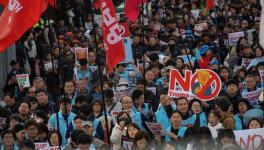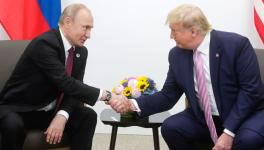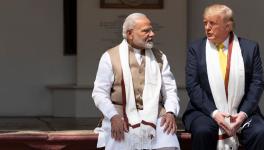A Sino-Russian Firewall Against US Interference
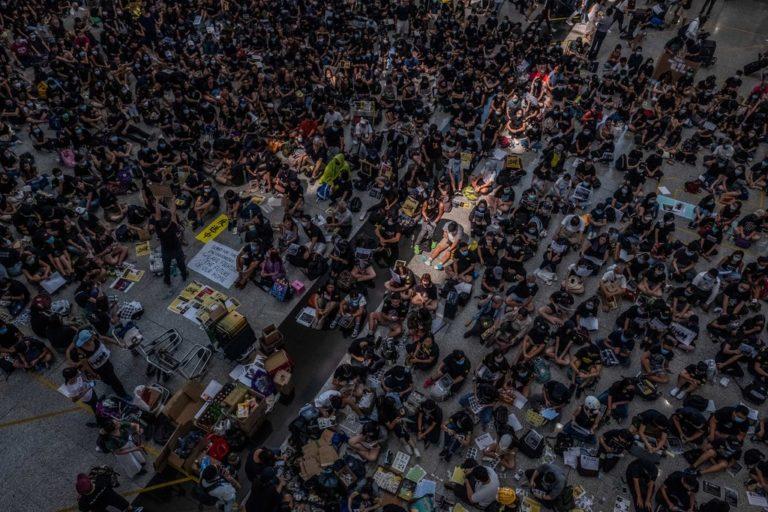
A sit-in at Hong Kong international airport, Aug 9, 2019
China has explicitly accused the United States and Britain for fomenting the “pro-democracy” protests in Hong Kong. Beijing has taken up the matter via the diplomatic channel demanding that the US intelligence should stop inciting and abetting the Hong Kong protestors. Last week photographic evidence appeared in the media showing the political counsellor in the US consulate in Hong Kong Julie Eadeh confabulating in the lobby of a local luxury hotel with the student leaders involved in Hong Kong’s pro-democracy movement.
Washington has taken umbrage that Julie’s cover has been blown. She is apparently an expert who organised “colour revolutions” in other countries and it has been disclosed that she was involved in plotting “subversive acts” in the Middle East region. The Global Times wrote a blistering editorial. It said:
“The US administration has played a disgraceful role in the Hong Kong riots. Washington publicly supports the protests and never condemns violence that targets police. The US consulate general in Hong Kong is stepping up its direct interference in Hong Kong’s situation. The US administration is instigating turmoil in Hong Kong the way it stoked “colour revolutions” in other places worldwide.”
Is the Chinese allegation plausible? Writing in the Asia Times, the noted Canadian academic, economist and author Ken Moak made a good point recently that the protests are lavishly funded and their logistics and organisation are of a scale taxing resources that “only foreign governments or wealthy individuals who might profit from them” would commit. He detailed past instances of Anglo-American attempts to destabilise China.
Moak anticipates “more intense and violent” subversive operations against China by the US in the future.
Indeed, agents provocateurs are calibrating the protests almost on daily basis such as burning the Chinese flag and occupying the Hong Kong airport. The game plan is to force Beijing to intervene so that the deluge follows — western sanctions, et al.
With the 5G technology just about rolling out, this is an opportune time for the US to frogmarch its western allies into an economic boycott of China when countries like Germany and Italy that have flourishing trade and investment ties with China are loathe to get into the American bandwagon.
The well-known Italian journalist and author and long-time China watcher based in Beijing, Francesco Sisci wrote recently that Hong Kong is in reality Beijing’s “safety valve” and choking it can cause asphyxiation to the entire Chinese system. Sisci compares Hong Kong with “a compensation chamber, a safety valve between the closed economy of mainland China and the open economies of the rest of the world.”
If China could globalise avidly and yet keep its economy closed, it was because it had Hong Kong, which was completely open and provided the third-largest financial market in the world. If large-scale capital flight ensues in Hong Kong, China will have to work its future financial arrangements through countries over which it it doesn’t have political control. To quote Sisci, “Hong Kong’s present status can help Beijing buy time, but the crucial issue is still the status of China. The time of being both in and out the global commercial system thanks to a complex architecture of special agreements is rapidly running out.”
Simply put, the unrest in Hong Kong becomes a template of the US’ maximum pressure approach to break China’s growth momentum and its ascendancy as a rival in technology globally in the 21st century. The influential China hands in the US are already opening the champagne bottle that “revolution is in the air in Hong Kong” — and, it will mark “the end of communism on Chinese soil.”
Enter Russia. Coincidence or not, small fires are being lit lately on the Moscow streets as well, and they are spreading into significant protests against President Vladimir Putin. If the extradition law was the pretext for the Hong Kong turmoil, it is the election to the Moscow Duma (city legislature) that has apparently triggered the Russian protest.
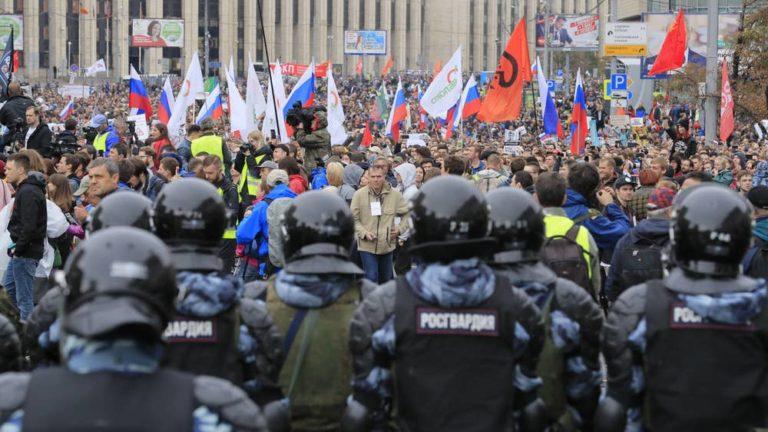
Protestors in Moscow, August 10, 2019
Just as there is economic and social discontent in Hong Kong, the popularity of Putin has declined lately which is attributed to the stagnation of the Russian economy.
In both cases, the American agenda is blatantly “regime change”. This may seem surprising, since the Chinese and Russian leaderships appear rock solid. The legitimacy of the Chinese Communist Party over which President Xi Jinping presides and the popularity of Putin still at a level that is the envy of any politician anywhere in the world, but the doctrine of “colour revolutions” is not built on democratic principles.
Colour revolutions are about upturning an established political order and it has no co-relation with mass support. The colour revolution is coup by other means. It is not even about democracy. The recent presidential and parliamentary elections in Ukraine exposed that the colour revolution of 2014 was an insurrection that the nation disowns.
Of course, the stakes are very high when it comes to destabilising China and Russia. Nothing less than the global strategic balance is involved. The US’ dual containment strategy against Russia and China is quintessentially the New American Century project — US’ global hegemony through the 21st century.
The US wagered that Moscow and Beijing would be hard pressed to cope with the spectre of colour revolutions and that would isolate them. After all, authoritarian regimes are exclusive and into the sanctum sanctorum of their internal politics not even their closest friends or allies are allowed in.
This is where Moscow has sprung a nasty surprise for Washington. The Russian Foreign Ministry spokesperson Maria Zakharova said in Moscow on Friday that Russia and China should exchange information on the US interference in their internal affairs. She flagged that Moscow is aware of the Chinese statements that the US interferes in Hong Kong affairs and treats this information “with all seriousness.”
“Moreover, I think it would be right and useful to exchange such information through respective services,” Zakharova said, adding that the Russian and Chinese sides will discuss the issue soon. She added that the US intelligence agency is using technology to destabilise Russia and China.
Earlier on Friday, the Russian Foreign Ministry had summoned the head of the Political Section in the US embassy Tim Richardson, and presented him with an official protest against the US encouraging an unauthorised opposition rally in Moscow on August 3.
Indeed, Moscow is far more experienced than Beijing in neutralising covert operations by the US intelligence. It is a hallmark of the great skill and expertise as well as the tenacity of the Russian system that through the entire Cold War era and “post-Soviet” period, there has never been anything like the turmoil on Tiananmen Square in Beijing (1989) or Hong Kong (2019) triggered by the US intelligence.
Moscow’s message to Beijing is direct and candid — ‘United we stand, divided we fall.’ No doubt, the two countries have been in consultation and wanted the rest of the world to know. Indeed, the message Zakharova transmitted — on a joint firewall against US interference — is of epochal significance. It elevates the Russia-China alliance to a qualitatively new level, creating yet another political underpinning of collective security.
Get the latest reports & analysis with people's perspective on Protests, movements & deep analytical videos, discussions of the current affairs in your Telegram app. Subscribe to NewsClick's Telegram channel & get Real-Time updates on stories, as they get published on our website.












